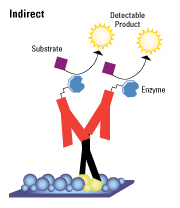Western blot antibody detection is used vary widely. Common variations involve in direct detection and indirect detection. Through the direct detection method, the primary antibody used to detect an antigen on the blot is labeled with fluorescent dye or an enzyme. Most researchers prefer the indirect detection method, the direct detection method is not used widely. In the indirect detection method, to bind to the antigen, a primary antibody is added first, either monochlonal antibody or polyclonal antibody. This is followed by a labeled secondary antibody that is directed against the primary antibody. Labels include biotin, fluorescent probes, such as fluorescein or rhodamine, and enzyme conjugates such as alkaline phosphatase (AP) or horseradish peroxidase (HRP). The indirect detection method has many advantages over the direct detection method.
Western blot indirect detection vs. Western blot direct detection:
Now, we are talking the western blot antibody detection steps: The unbound secondary antibodies are washed away, and the enzyme substrate is incubated with the membrane so that the positions of membrane-bound secondary antibodies will emit light. Bands corresponding to the detected protein of interest will appear as dark regions on the developed film. Band densities in different lanes can be compared providing information on relative abundance of the protein of interest.
The new generation of film developers are units with a camera inside an enclosure, removing the need for a darkroom. The camera detects the chemiluminescence emanating from the membrane, transforming the signal into a digital image for rapid analysis with software provided with the detection machine.
Three ways for western blot antibody detection:
1. Chemiluminescence method for western blot detection
2. Fluorescence method for western blot detection
3. Chemical coloration method for western blot detection




